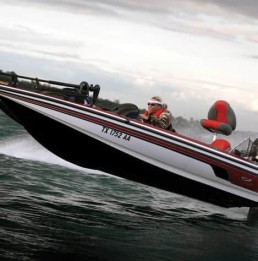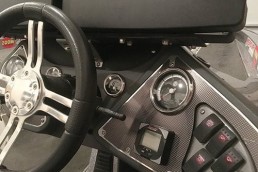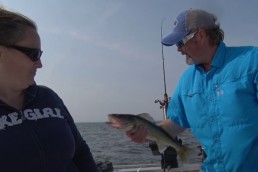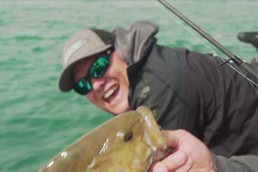Boat Control: Mastering Safety and Precision
SHARE THIS POST
There’s this not-so-funny thing that happens when you have to schedule summer vacations months in advance: you wake up on fishing days and are greeted with less-than-ideal weather conditions. It happens when you hit local lakes on the weekends, too.
Wind, especially, is a force to be reckoned with. There’s a difference between a walleye chop and a power wind that makes you think twice about trying to fish that offshore hump. If you’re new to operating the boat, a stiff breeze can make you think twice about launching at all.
We sat down with the guys from Warrior Boats and talked about handling boats on rough water, and the fine points of boat control. As we enter the heart of boat shopping season and wait for ice to melt, it gives us all fuel to fight cabin fever, and advice that can help make it a safe, successful season.
Handling rough seas
When it comes to safely handling a boat in rough water, Warrior’s Chuck Barth, a lifelong fisherman and tournament competitor, points out that there’s often a sweet spot when it comes to speed. Too many boaters try to maintain top speeds when they would gain significant control by slowing down.
“Safety always seems to be more of a speed thing than anything else,” says Barth, one of four partners at Warrior. “You don’t have to be going wide open; there is such a thing as throttling down. I do that a lot. I don’t have to hold my engine at 5,500 RPMs and 56 miles an hour; a lot of times, I hold it at 4,000 and go 40 miles an hour. Or even slower.
“You have to operate the boat according to the conditions, and your abilities. Don’t get in the boat and think you have to open it up. You need to get used to everything – the control of the boat, the motor, the wind, everything.”
“Choosing the right motor for your boat is an often-overlooked factor that plays a huge role in performance, control, and safety,” added Al Lienen, another partner in the Warrior ownership group, and serious fisherman. “You see it a lot where a smaller motor is sold with a boat, in order to reduce the cost. But on the water, that boat just can’t perform like it should, because it’s underpowered. We stress to our customers how important it is to put a motor on their boat that’s big enough to handle it.”
When it comes to how you should approach boating in the waves, Barth has advice, and agrees with Lienen.
“The number one thing is you need a big enough motor so that, if you are running with the waves, you can stay ahead of the waves. You don’t want the waves to catch you. If you’re running into the waves, I think you should quarter them. You don’t seem to spear ‘em like you do if you’re heading directly into the waves.
“Every boat has its capabilities, but all boats seem to handle better when you quarter into the waves rather than hit ‘em head on. And it depends on the size of the waves and how your boat handles. Sometimes a two-foot wave is enough for you to have to back off on the throttle, but in a different boat you might be able to go flying across that same water and not even notice (the waves) are there. I see some guys going across the water driving too fast for what their boat can handle, and I don’t know how they even stay in the boat. And they wonder why their equipment is wrecked when they get to the other side of the lake. There’s such a thing as common sense. We can’t forget that.”
Are you enjoying this post?
You can be among the first to get the latest info on where to go, what to use and how to use it!
Learning boat control
Barth points out that every boat you climb into performs differently, so you need to spend time with a boat-and-motor combination to learn what it can and can’t do–and things change as you add more passengers and/or gear. More weight inside the boat, and how that weight is distributed, can change the dynamics for the captain.
If you’re new to boating, he says, consider asking someone with experience to give you an on-the-water lesson. “If you go out with somebody who’s skilled at boat control,” he says, “you can learn a lot in a short time. You can get a quick sense of how to handle the basics, but then you have to spend time doing it yourself, so you get comfortable. Nothing is better than time on the water.”
Fishing skills
Beyond safety considerations, anglers need to strive for precise boat control when pursuing fish. Often, the ability to accurately follow a contour (keep the boat in the same depth as you move along) or stay on a piece of structure is a difference maker. Walleye anglers, in fact, often present the bait with the boat, using techniques like backtrolling and controlled drifting.
So how do you get good at this elusive set of skills? The time-proven method involves using a depthfinder and the motor to constantly monitor where you are and keep the boat in a specific depth. The recent development of GPS units that superimpose digital contour maps on the display let you see where you are (your boat’s icon shows up on top of the map), which is a huge help. Both Barth and Lienen talked about an even-more-recent development that allows technology to make you instantly better at boat control.
“With the invention of the (Minn Kota) Terrova trolling motor,” Lienen said, “which can be connected to your electronics, you can set a depth level and stay on it automatically. You can tell your trolling motor you want to stay at 17 feet, and it stays on that level all the time. We didn’t have that luxury before. (Other models have similar capabilities.)
“It’s bringing whole new possibilities to us. If you mark fish on your depthfinder, you can take your cursor and mark a spot right where the fish are and tell your trolling motor to go back to that spot. And you can lock it on that spot and it will keep you on or very close to that spot.”
The vagaries of weather and the pursuit of fish take us on rough waters. The best memories go to those who can operate a boat safely and precisely, even in difficult conditions. Hopefully, these tips will help you have a great season on the water.
For more information…
To learn more about Warrior Boats, including the Smart Trolling Keel and deep-V reserve flare hull design that directs splashing away from the side of the boat, go to warriorboatsinc.com. Because of the time it takes to custom craft each boat, there is time to order additional items and have them installed at the factory, including sonar, GPS, electric motors, etc. Lienen “caters to their customers” and sets their boat up “just how they want it.”
MWO
SHARE THIS POST
Did you enjoy this post?
You can be among the first to get the latest info on where to go, what to use and how to use it!
MWO
We believe being outdoors is good. With more than 1,000 articles each year, MidWest Outdoors magazine is all about sharing outdoor experiences with you—where to go, what to use and how to use it… whether you’re close to home or on that trip of a lifetime.



